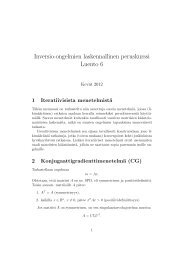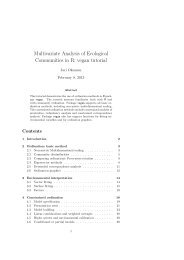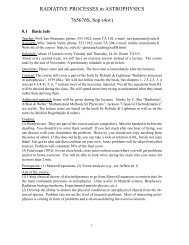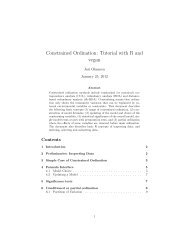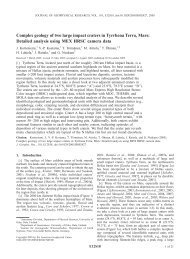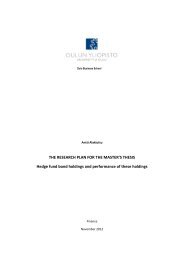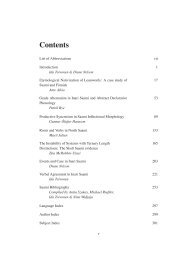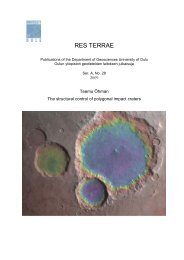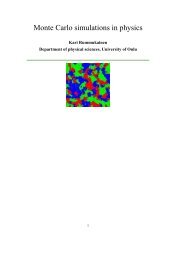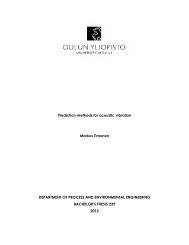Juha Köykkä - Oulu
Juha Köykkä - Oulu
Juha Köykkä - Oulu
- TAGS
- juha
- oulu
- cc.oulu.fi
Create successful ePaper yourself
Turn your PDF publications into a flip-book with our unique Google optimized e-Paper software.
Res Terrae, Ser. A 32, J. <strong>Köykkä</strong>, Sedimentology of the Mesoproterozoic Telemark basin-fills, South Norway: implications for<br />
sedimentation processes, depositional environments and tectonic evolution<br />
during the syn-rift stage. The sedimentation basin subsidence was caused by tecton-<br />
ism, sediment-volcanic loading and crustal densification. The basin entered the late<br />
syn-rift stage gradually, where the connection between the rift structure and shallow<br />
marine waters was established and the volcanism terminated. At the late syn-rift stage,<br />
the transgression and associated erosion reworked the underlying sediments, and a<br />
newly formed bay may have acted as a sediment sink for clastic detritus transported by<br />
alongshore currents in a shoreline. This was followed by tidal sedimentation, and the<br />
cooling of the lithosphere eventually caused the basin subsidence to slow. The basin<br />
then entered its post-rift stage. The crust, including the basin, continued to subside on<br />
a larger scale. The fluvial incision and sedimentation indicate a base level drop, the<br />
filling of the basin and a shoreline advancing further to the sea. At the end of the early<br />
post-rift stage and the late post-rift stage, the shallow marine conditions returned and<br />
covered wide areas accompanied by base level transgression and the landward migra-<br />
tion of the shoreline. The late syn-rift stage was characterized by subtidal and high-<br />
energy nearshore sedimentation patterns in an overall trangressive setting, which was<br />
studied in Paper III. A delicate balance between sediment supply and accommodation<br />
space creation was achieved, which resulted in sediment accumulations several kilo-<br />
meters thick. The whole rift was buried under shallow shelf deposits.<br />
When comparing the Rjukan Rift Basin to, for example, the East African Rift<br />
(Frostick et al., 1986) and mid Jurassic Alp rift basins (Loup, 1993), notable differenc-<br />
es in sedimentation patterns appear, including a lack of deep water (turbidites, olisto-<br />
stromes, and megabreccias) and carbonate sediments. The lack of a deepwater sedi-<br />
mentation prism and oceanic crust as well as the non-evolution to passive margin set-<br />
ting could indicate that the rifting in the Rjukan Rift Basin failed to complete the<br />
break-up of the continental crust. The high input of terrigenous siliciclastic sediments,<br />
possible cold-climate conditions, and other factors prevented the ignition of the carbo-<br />
nate factor in the Rjukan Rift Basin. The erosional unconformity (sub-Heddersvatnet<br />
unconformity), clastic sedimentation starvation and voluminous bi-modal volcanism in<br />
the syn-rift stage indicate an active rift model (Sengör and Burke, 1978; Frostick and<br />
Steel, 1993). In an active rifting setting, the surface deformation is associated with the<br />
impingement of a thermal plume or sheet on the base of the lithosphere. Although the<br />
dip of bounding faults is difficult to estimate, the thick accumulation of sediments (ca.<br />
66



